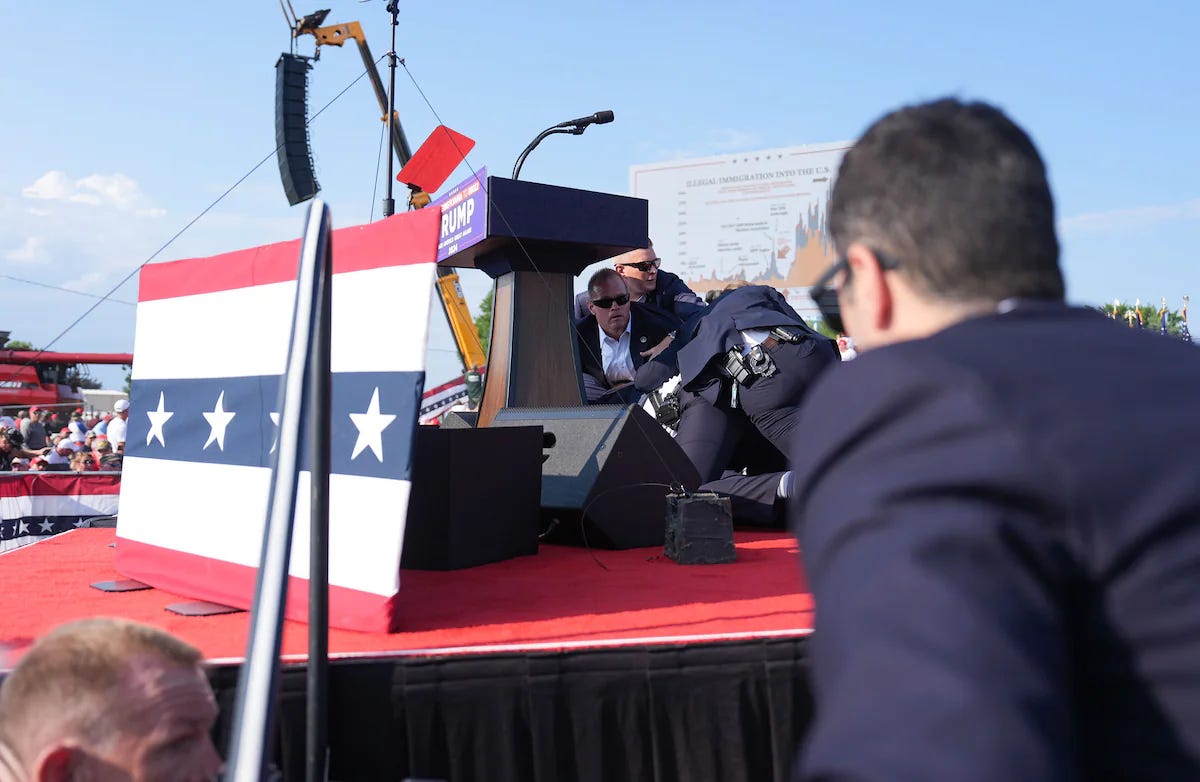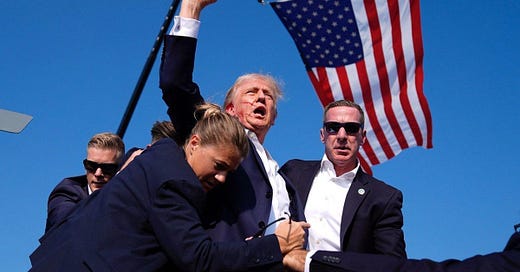Secret Service Internal Investigation: Security Lapses at Trump Rally
The gaps were glaring. Everyone is wiser in the hindsight. Will the Lessons be Learnt?
Serious Security Lapses at Trump Rally
Introduction
An internal investigation by the Secret Service has revealed critical security failures during an election rally for former President Donald Trump in Butler, Pennsylvania, on July 13, 2024. This incident saw an attempted assassination of Trump, which resulted in the death of one spectator and the critical injury of two others. The shocking event has raised questions about the agency's professionalism as well as preparedness and has highlighted significant breakdowns in communication and strategy, which— if plugged— could have prevented the tragedy.
Breakdown of Security Measures
The investigation, formally known as a Mission Assurance probe, exposed glaring flaws in the Secret Service’s efforts to secure the rally. Perhaps the most significant failure was the lack of attention to the roof of the Agr International building, from which the shooter, Thomas Matthew Crooks, opened fire. While local police had flagged Crooks as suspicious before the event, these concerns were not communicated effectively to the Secret Service agents on the ground. Crooks managed to position himself on the rooftop, firing at Trump, grazing his ear, and fatally injuring a spectator.
Compounding the tragedy was the fact that key preventative measures, such as positioning heavy equipment or visual barriers between the building and the rally stage, were considered but not executed. These oversights created a clear line of sight for the gunman, allowing the attack to unfold with devastating consequences.
Failures in Communication Systems
One of the most alarming findings of the investigation was the Secret Service's inadequate communication system, which was operating in isolation from local law enforcement. This separation meant that real-time alerts from local police, who were monitoring the crowd and perimeter, were not received by Secret Service agents in time to prevent the attack.
Despite local police noticing Crooks behaving erratically near the building, they were instructed to send a photo of him to a single Secret Service agent via text message, rather than broadcasting the information across all agents. This piecemeal approach, coupled with a command post system that kept Secret Service agents and local police in separate facilities, delayed the recognition of the threat and ultimately contributed to the failure to neutralise it before shots were fired.

Changes Ordered by the Secret Service
Following these revelations, Secret Service Acting Director Ron Rowe publicly expressed his deep embarrassment over the agency’s failure, particularly in the face of intelligence warnings that indicated an Iranian plot targeting U.S. political figures. Several high-ranking officials, including Assistant Director Mike Plati, have since resigned.
In response, Rowe has implemented several changes to address these critical security gaps. Among them is the decision to co-locate Secret Service agents and local police in the same command centers for future events, ensuring a unified approach to threat identification and response. These changes are expected to streamline communication and prevent the kind of fragmentation that allowed Crooks to evade early detection.
Bipartisan Concerns and Future Steps
The security breakdown at the Butler rally has sparked bipartisan outrage, with lawmakers from both parties condemning the Secret Service’s failings. Senator Richard Blumenthal, who sits on the Senate Homeland Security Committee, expressed dismay at the agency’s inadequacies, promising that the public would be "shocked, astonished, and appalled" by the findings. The probe has also confirmed earlier media reports that suggested local law enforcement’s warnings were dismissed or underprioritised.
With multiple investigations still ongoing—including reviews by the FBI, the Department of Homeland Security, and Congress—these findings are likely to have far-reaching implications for the future of political event security in the United States. A report from an independent panel commissioned by the DHS is expected to shed further light on the attack and recommend comprehensive reforms.
Escalating Concerns over Future Rallies
In the wake of the assassination attempt, there has been growing concern over the security arrangements at future political events, particularly those involving high-profile candidates like Donald Trump. The campaign, now far more cautious, has begun to demand more robust and visible security measures, including additional snipers, heightened barriers, and a broader protective perimeter around rally sites. This has led to increased tension between Trump’s team and the Secret Service, as the former president’s aides push for stronger safeguards.
The attempted assassination has already forced the campaign to cancel or delay several rallies, and the aftermath of the Butler incident is reshaping how future events are organised. The Trump team, already wary of security issues, is taking these failures seriously, further intensifying the scrutiny around the Secret Service’s capabilities. As Trump’s rallies continue to draw significant crowds and attention, the need for bulletproof security is now more urgent than ever.
Resignation of Secret Service Director Amid Bipartisan Criticism
Kimberly Cheatle, the former Director of the Secret Service, faced intense scrutiny following the security failures at the Trump rally in Butler, Pennsylvania. After being grilled by a congressional committee and enduring bipartisan criticism, her position became untenable. Both lawmakers and independent security experts sharply criticised her handling of the incident, both before and after the attack, as well as her delayed response in addressing the agency’s internal failures. Cheatle ultimately resigned in the aftermath, paving the way for a new internal investigation led by Acting Director Ron Rowe, who has since implemented key reforms to strengthen the agency’s operations.
Timeline of Events Leading to the Shooting
The internal investigation conducted by the Secret Service outlined a detailed timeline of the events leading up to the attempted assassination of former President Donald Trump at a rally in Butler, Pennsylvania, on July 13, 2024. At 5:51 PM, Pennsylvania State Police reported a suspicious individual with a rangefinder near the rally site. This information was quickly relayed to Secret Service counter-sniper teams and response agents by 5:52 PM. Despite this warning, Trump took the stage at 6:03 PM, and at 6:11 PM, the gunman opened fire from a nearby rooftop. The timeline revealed a significant 20-minute window between the first alert and the actual shooting, raising concerns about why the threat was not neutralised in time.
Security and Communication Failures
One of the most glaring failures highlighted in the investigation was the inadequate security perimeter. The gunman managed to access a rooftop just 410 feet from where Trump was speaking, a location that should have been secured or placed under surveillance. This lapse allowed the shooter to gain a clear vantage point. Compounding the issue were communication and coordination failures among the nine different local, county, and federal law enforcement divisions responsible for securing the event. The investigation revealed missteps in the sharing of critical information, and the Secret Service failed to disseminate the threat warning effectively, leaving gaps in the overall security strategy.
The Re-Emergence of Kamala Harris
As the dust settles from the attempted assassination, the political landscape remains fluid. Initially, the attack seemed to have galvanised Trump’s support base, propelling him into a commanding position in the 2024 race. However, subsequent events have rebalanced the political chessboard. Vice President Kamala Harris, previously trailing in the polls, has made a strong comeback, energised by her renewed focus on social issues, immigration, and national security. Her reinvigorated campaign has gained momentum, closing the gap that once appeared insurmountable.
While the failed assassination attempt briefly looked as if it had handed Trump a decisive advantage, Harris’s resurgence has reshaped the contest. With her newly energised campaign and Trump’s security concerns continuing to plague his rallies, the 2024 election has become highly unpredictable. As it stands now, the race is wide open, and it is anyone's game1.
Trump Survives Assassination Attempt: Of Bullet, Blood, Ballot, and Bravery
Divine Intervention or Mere Coincidence?





